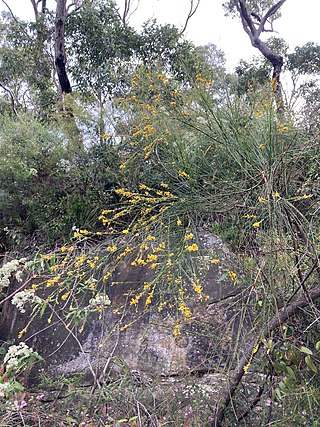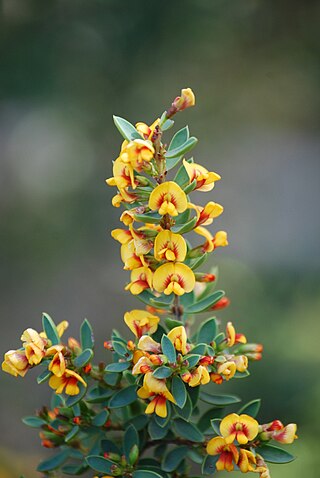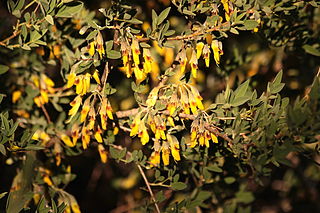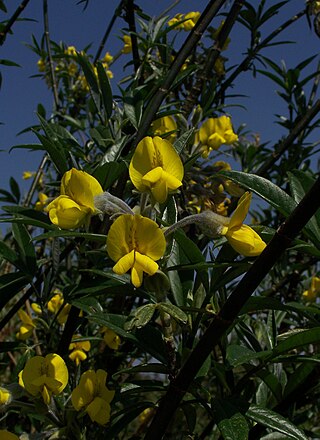
Argyrocytisus battandieri, the pineapple broom or Moroccan broom is a species of flowering plant in the legume family, Fabaceae, subfamily Faboideae. It is the only member of the genus Argyrocytisus.
Podocytisus caramanicus is a species of flowering plant in the family Fabaceae. It is a shrub native to the western Balkan Peninsula and southern Turkey. It is the only member of the genus Podocytisus. It belongs to the subfamily Faboideae.

Viminaria juncea is the single species in the genus Viminaria endemic to Australia. The genus is in the pea family Fabaceae. It is colloquially known as native broom after its resemblance to the related European broom plants. The Noongar peoples know the plant as koweda.
Almaleea is a genus of perennial shrubs from the family Fabaceae native to Australia.

Aotus is an Australian genus of flowering plants, within the legume family Fabaceae. Aotus species, together with other species of the tribe Mirbelieae, are often called golden peas because of their distinctive small yellow flowers. They are endemic to Australia, occurring in all states except the Northern Territory. Aotus are evergreen species. Some are widely cultivated by gardeners for their ornamental value.

Eutaxia is a genus of the family Fabaceae. They are native to Australia. Most are endemic to the Southwest Botanical Province of Western Australia, but a few are distributed throughout mainland Australia. The chromosome number of Eutaxia species is typically 2n = 14 or 16.

Templetonia is a genus of flowering plants in the family Fabaceae. They are native to Australia. The genus is named in honour of John Templeton, an Irish naturalist and botanist.
Haplormosia is a monotypic genus of legumes in the family Fabaceae. Its only species is Haplormosia monophylla, commonly known as Liberian black gum, native to Cameroon, Ivory Coast, Liberia, Nigeria, and Sierra Leone. It is threatened by habitat loss.

Sakoanala is a genus of legume in the family Fabaceae. It contains two species which are endemic to Madagascar.

Adenolobus is a genus of African flowering plants in the legume family, Fabaceae. It belongs to the subfamily Cercidoideae.
Baudouinia is a genus of flowering plants in the legume family, Fabaceae. It includes six species which are all endemic to Madagascar. It belongs to the subfamily Dialioideae.

Anagyris is a genus of flowering plants in the family Fabaceae. It belongs to the subfamily Faboideae.

Calicotome is a genus of flowering plants in the family Fabaceae. It includes five species native to the Mediterranean Basin. The genus belongs to the subfamily Faboideae. It may be synonymous with Cytisus. All species of the genus are thorny shrubs. The ancient Greeks believed that tyrants in Hades were punished by being beaten with the thorny calycotomes.

Euchresta is a genus of flowering plants in the family Fabaceae. It belongs to the subfamily Faboideae. It includes four species native to eastern and southeastern Asia, from the eastern Himalayas to Indochina, southern China, Korea, Japan, Taiwan, and Malesia.

Eysenhardtia is a genus of flowering plants in the family Fabaceae. It belongs to the subfamily Faboideae. Members of the genus are commonly known as kidneywoods.

Hesperolaburnum platycarpum is a species of flowering plants in the family Fabaceae. It belongs to the subfamily Faboideae. It is the only member of the genus Hesperolaburnum. It is a tree or shrub endemic to Morocco.

Hypocalyptus is a genus of flowering plants in the legume family, Fabaceae. It includes three species of shrubs, subshrubs or small trees native to the Cape region of South Africa. Typical habitats include Mediterranean-climate shrubland (fynbos) at forest margins, in rocky and sandy areas, and along streams, often at high elevations.

Piptanthus is a genus of flowering plants in the legume family, Fabaceae. It includes two species of shrubs native to the Himalayas, Tibet, Myanmar, and western China. They grow in montane grassland, thicket, and forest margins.
Sellocharis paradoxa is a species of flowering plants in the family Fabaceae. It belongs to the subfamily Faboideae. It is native to southern Brazil and is the only member of the genus Sellocharis.
Stonesiella selaginoides, the clubmoss bush-pea, is a species of flowering plant in the family Fabaceae. It belongs to the subfamily Faboideae. It is the only member of the genus Stonesiella and is endemic to Tasmania. It is named to recognise Australian botanical illustrator Margaret Stones.














